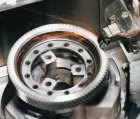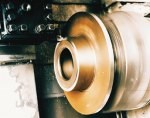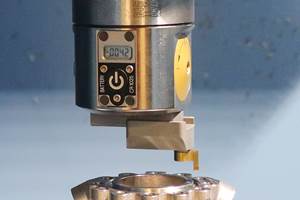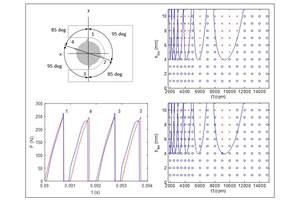Extending The Range Of PCBN
Thicker inserts and a wider variety of styles are allowing PCBN to be applied to a growing range of hard, ferrous applications.
For many years, PCBN (polycrystalline cubic boron nitride) cutting tools have offered the important advantage of vastly superior edge integrity in machining alloy steels with hardnesses greater than 45 Rockwell C, as well as various types of cast irons and cast steels. Now, new advances in the design and use of PCBN cutting tools provide capabilities for both improved performance and a wider range of applications within these operating parameters. The availability of new thicker PCBN solid inserts with increased grain size, for example, makes possible efficient machining of difficult cast iron alloys that were previously processed exclusively by grinding.
The larger PCBN particle size provides both better wear resistance and impact resistance. That's key to productive machining of materials such as cast irons with less than 10 percent ferrite content. In roughing operations on parts of this type, good impact resistance is essential to withstand the cracks, sand inclusions, and other interruptions left by the casting process. For finishing, excellent abrasion resistance is needed, since the parts can contain 28 to 30 percent chrome and have a Rockwell hardness between 68 and 72.
The latest solid PCBN inserts also offer improved reliability and economy. With 3/16-inch cross sections—up from the traditional 1/8 inch—they can be held securely in standard carbide insert toolholders using shim seats. Moreover, the solid PCBN construction provides multiple cutting edges on two sides, reducing the insert cost per part produced.
Besides the new thicker solid style, today's PCBN inserts are also available in "full-face" and "tipped" styles. The full-face style provides a complete top face of PCBN sintered onto a carbide substrate. These inserts are not as costly as solid PCBN inserts, but provide multiple cutting edges on one side only. Most PCBN inserts used today are of the lower-cost "tipped" variety. Inserts in this style contain a small brazed-in PCBN segment in one corner of an otherwise carbide insert and provide either a single cutting edge or double cutting edges. Both the full-face and tipped PCBN insert styles are of industry-standard size. Like the latest solid style, they can be used in the insert pockets of standard carbide toolholders and milling cutters.
Machining Conditions And Parameters
Hard-part machining with PCBN is best applied to workpieces with at least a 45 Rockwell C hardness rating. At least, that's the practical low end on which most people in the industry agree. This is not to say you can't use PCBN to machine parts with a lower hardness, but insert cratering is a problem in those applications.
In PCBN roughing operations, maximum depths of cut using solid-style inserts range from about 3/16 inch on white iron and other hard, high-chrome irons, to upwards of ¼ inch on non-chrome "clean" cast irons. Finishing speeds can range from 350 to 400 sfm on high-chrome irons up to 7,000 sfm on gray cast irons. For all PCBN operations, a very rigid setup is mandatory. That includes the tooling itself, the work fixturing, the machine spindle, and the machine tool in general.
Appropriate PCBN finishing speeds will vary dramatically depending on the work material, the material hardness, and the part size and shape. On hardened steels in the range of 60 to 62 Rockwell, you can run about 600 sfm at a 0.020-inch depth of cut. With a feed rate of 0.002 to 0.004 ipr, that will normally give you a fine surface finish in the range of 8 rms. In machining somewhat harder materials, you might have to go a little faster—but even there, 650 sfm is about tops. Above that speed, you're going to get excessive wear. Obviously, you can go much faster on plain cast irons.
Using The Right Insert Style
Another important consideration in PCBN machining is the choice of solid, full-face, or tipped inserts. Tipped PCBN inserts are economical and reliable for a wide range of roughing and finishing applications, but there are some applications where you're definitely better off using a solid or full-face insert.
An example is the rough boring of cylinder liners where casting flash is present in the middle of the part. If you used a tipped insert here—even running at exactly the right depth of cut—there's a good chance the flash could eventually displace the PCBN segment. That couldn't happen with the stronger solid or full-face PCBN insert. Both the solid and full-face insert styles also offer the bonus of regrindability, providing extended use that can help balance their higher initial cost.
Either the solid or full-face PCBN insert style can serve well in a cylinder-liner-with-flash application. The solid inserts have a higher initial cost. To use them cost-effectively, you need to make sure the application allows you to use cutting edges on both sides.
The largest recent growth in the use of PCBN inserts is in the area of hard turning—in particular, the finish turning of steel-alloy automotive engine components, such as gears, shafts and bearings, that have hardnesses between 60 and 65 Rockwell C. These parts have traditionally been ground to very tight dimensional tolerances and a fine surface finish. Now you can get the same results with a CNC lathe that probably costs only about half as much as a CNC grinder and is also far less costly to maintain.
Lower-cost PCBN-tipped inserts can be used for these hard-turning operations, since depth-of-cut requirements are light—in the range of 0.012 to 0.015 inch. In our tests with tipped inserts at Carboloy, hardened steel components in the 60 to 62 Rockwell C range were consistently machined to surface finishes of 8 micro inches or less.
Optimizing PCBN Applications
The starting point for any productive PCBN application is a secure and rigid setup. A contribution to that end is the thicker cross section (3/16 inch) of the latest solid-style PCBN inserts, which allows the inserts to be held securely in standard toolholders using shim seats. Beyond that, today's CNC lathes and machining centers can provide all the rigidity required to successfully apply PCBN cutting tools. With a growing economy, the population of new machines is rapidly increasing, providing a friendlier environment for the use of high-performance cutting tool materials.
Generally speaking, PCBN machining operations should be run dry. The PCBN material is hard enough to resist deformation from the heat generated in machining, but it is also brittle enough to crack from the thermal shock of coolant. That's especially true in the case of interrupted cuts. Never use coolant in PCBN operations where the cut will be interrupted.
Insert edge preparation is another operating condition that can strongly influence the success of PCBN machining. Keep in mind that the PCBN insert is a small piece of hard, brittle cutting material that you are going to run into a workpiece material that may have a hardness of 62 Rockwell.
To promote good tool life, the cutting edge of the PCBN insert must be reinforced with the proper edge preparation. That can range from a small hone for finish-machining cast irons, to a T-land measuring 0.150 inch wide by 15 degrees for heavy roughing of white iron. Combined lands and hones may also be used. By adding a land to the insert, you increase and strengthen the cutting edge. For example, if you have a 90-degree corner to start with and add a 20-degree land, you now have a 110-degree corner. The larger the corner angle, the stronger your cutting edge will be.
A general guideline for proper edge preparation of PCBN inserts is to keep the angle of the land proportional to the hardness of the work material, since the reinforced cutting edge will redirect cutting forces away from the edge. Thus, in machining cast irons, a light hone is appropriate for finishing operations and a T-land of about 0.008 inch by 20 degrees is best for roughing. For machining steels with hardnesses up to 65 Rockwell C, appropriate T-lands may range from 0.004 inch to 0.008 inch by 20 degrees.
The know-how, the tool technology, and the machine rigidity are all available today to apply PCBN cutting tools effectively over an expanded range of hard-part applications. Within their operating range, these tools are more reliable and cost-effective than ever. They can play an important role in achieving the productivity improvements every manufacturer needs to stay competitive.
About the author: David Huddle is product manager for advanced materials at Carboloy Inc., Detroit, Michigan.
Related Content
Best Practices: Machining Difficult Materials
Cutting hardened steel, titanium and other difficult materials requires picking the right tools, eliminating spindle runout and relying on best practices to achieve tight part tolerances.
Read MoreGrooving Attachment Streamlines Operation by 75%
A grooving attachment enabled Keselowski Advanced Manufacturing to reduce cycle times by over 45 minutes on a high-value, high-nickel part feature.
Read MoreThe Impact of Cutting Teeth Spacing on Machining Stability
Many cutter designs are available, and variable teeth spacing (or variable pitch) cutters can be used to influence milling stability. Let’s discuss why teeth spacing affects stability.
Read MoreA New Milling 101: Milling Forces and Formulas
The forces involved in the milling process can be quantified, thus allowing mathematical tools to predict and control these forces. Formulas for calculating these forces accurately make it possible to optimize the quality of milling operations.
Read MoreRead Next
The Cut Scene: The Finer Details of Large-Format Machining
Small details and features can have an outsized impact on large parts, such as Barbco’s collapsible utility drill head.
Read More











.png;maxWidth=300;quality=90)


















